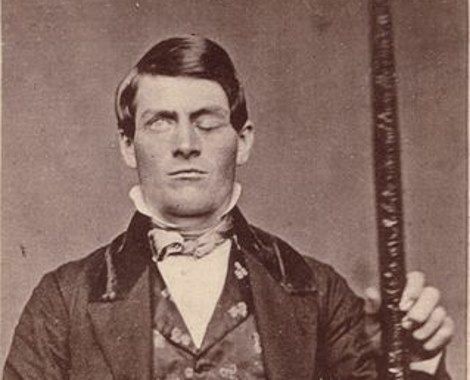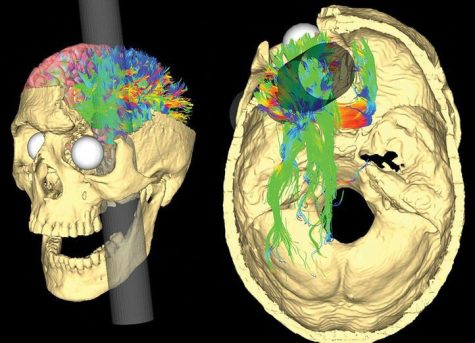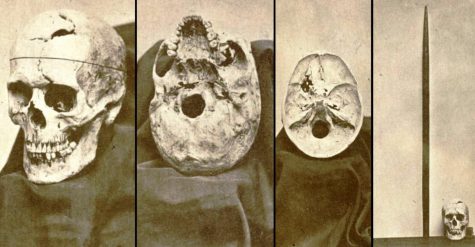Phineas Gage: The Man Who Survived the Impossible

April 8, 2022
Have you ever wondered if the impossible could happen?
We’ve all had those imaginative spikes, those sudden “what-if”s in the middle of our day. We’re no stranger to played out scenarios in our minds, but it is very rare that any of our fantastical make believes ever have substance.
This was not the case for the miraculous Phineas Gage: the man who survived a 1 1⁄4” pole shooting up clean through his scalp and hitting his brain.
Phineas Gage was born July 9th of 1833 and was the eldest of five children to his parents Jesse Eaton Gage and Hannah Trussell Gage. Much is unknown about his upbringing; however, we do know he had some kind of experience working with explosives on his family’s farm or in mines, which led him to take on a career in railroad construction.Mr. Gage was a well-built, happy bachelor, renowned by his physician John Martyn Harlow as “a perfectly healthy, strong and active young man.” He was perfectly capable of handling such a dangerous job, or so people thought.
In July 1848, he was employed for the construction of the Hudson River Railroad and took on the job as a blasting foreman. He was known as the best in town, as far as blasting goes. Employers from all over noted him as the “most efficient and capable foreman.”
However, on September 13th of 1848, this promising career came plummeting to an end after a gruesome accident. Gage was setting up a blast, when he heard some friends behind him start talking to him. As he turned his head around and opened his mouth to start speaking, his tamping rod sparked on the inside of the rock, igniting the gunpowder loosely packed inside of the rock. The three-foot long tamping rod shot at Gage’s face, entering through his lower jaw, up his cheekbone, through his left eye and the left side of the brain, and then shot out of the top of his skull through the frontal bone.
His friends around him stood mortified as Gage fell over and rapidly convulsed his arms and legs, and then stood in complete shock as he got right back up again and was speaking as if nothing had just happened. He was able to walk by himself with little help, and was able to sit upright for the mile long journey back to his lodging town where he was able to receive help.The healing process was not easy. According to Edward H. Williams, a physician who helped mend the wound, “[Soon after arriving,] Mr. G. got up and vomited; the effort of vomiting pressed out about half a teacup full of brain [through the exit hole at the top of the skull], which fell upon the floor.” He also writes: “His person, and bed on which he laid, were literally one gore of blood.” Another source remarks that every 15 to 20 minutes, Gage would regurgitate swallowed blood.
The story ends on a positive note, however, as the two physicians (Harlow and Williams) succeeded in mending Mr. Gage’s wound. Phineas Gage would go on to live another dozen years, before passing away on May 21st, 1860, due to an epileptic seizure, something that is noted to be related to his injury.Nonetheless, Gage served as a very important subject for neurology and neurologists everywhere, quite literally sparking the ongoing flame for brain studies. The pole attacked his frontal lobe, and because of this, Gage suffered from a drastic personality change after the accident. This taught us something useful; however, complex functions such as decision-making and social cognition are largely dependent on the frontal lobe.
In addition, Gage serves to prove a point. A point that the impossible is possible. A point that says, “Don’t get too comfy, because your world can turn up upon its head.” His skull is now display at the Warren Anatomical Museum, along with the pole that shot through his head all those years ago. Though it’s been a long time, the “American Crowbar Case” will be an influential part of neurology for the rest of time.
( https://www.verywellmind.com/phineas-gage-2795244 – https://www.npr.org/sections/health-shots/2017/05/21/528966102/why-brain-scientists-are-still-obsessed-with-the-curious-case-of-phineas-gage – https://mysteriesrunsolved.com/2021/07/phineas-gage-man-lived-after-his-brain-was-impaled-with-an-iron-rod.html )

